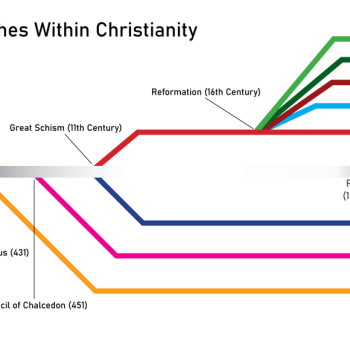Charismatic Christians consider “praise and worship songs” to be, in effect, sacramental, bringing worshippers into the presence of God. So observes Matthew Sigler, who supports this tradition. Furthermore, he says, the music and other features of contemporary worship, as the Charismatics devised it, unfolds in a specific sequence according to a theological model. That is (in my words), it is liturgical. Problems come, he says, when non-Charismatic Christians lift this music and these worship practices outside of their original context, borrowing them while leaving behind the theology and “pneumatology” that goes with them.
So worship implies a theology, and theology is embodied in worship. And you can’t just mix and match. It’s illuminating to hear this from a Charismatic perspective. And it is both illuminating and ironic to hear an advocate of contemporary worship (because of his Charismatic theology) agree with us advocates of traditional liturgy (because of our Lutheran theology). The link and an excerpt after the jump.From Matthew Sigler, Misplacing Charisma: Where Contemporary Worship Lost Its Way:
Many forget (or don’t know) that “contemporary” worship was inextricably linked to the Charismatic Movement of the 1960’s and 70’s. This connection forged a musical style that was rooted in a particular understanding of the Spirit in worship. Specifically, the singing of praise and worship songs was understood sacramentally. God was uniquely encountered, by the Spirit, in congregational singing.
Several important aspects of this theology of congregational song are worth highlighting. First, a premium was placed on intimacy with Jesus in congregational singing. This emphasis was largely due to the influence of John Wimber and the Vineyard movement of the late 1970’s and 1980’s. Though he was not the first to say so, Wimber emphasized that the Church needed to sing songs “to God” and not “about God.” Lyrically, this was manifest in the frequent use of the personal pronoun, “I.” Just scan through the catalogue of songs published by Vineyard Music during the 1980’s and see how many of them emphasize the importance of the individual engaging the second Person of the Trinity in the lyrics. While the intimacy motif wasn’t new in the Church, it was an important development in what would become known as “contemporary worship.”
Second, the dominant paradigm for congregational song was the “temple” metaphor. Charismatic congregations appropriated their understanding of the temple layout as a “map” for worship. Such services began with singing songs (typically upbeat) that focused on the praise of God—Scripture verses like Psalm 100 served as an anchor point for this framework. As the series of songs progressed, perhaps briefly interrupted with scripture and prayer, the flow of the service was understood to follow a metaphorical progression from the “outer courts” of the temple toward “the holy of holies.” Songs identified with the “holy of holies” were often slower, cyclical in construct, and emphasized intimacy between the singer and Jesus. This approach to worship is reflected in the way many referred to the music in these services as “Praise and Worship”—“praise” being synonymous with the “gates/outer courts” and “worship” was the term used primarily for songs corresponding to the “holy of holies.” While not every congregation that practiced this approach to worship would have articulated their theology of worship exactly this way, it certainly was the dominant understanding of Charismatic congregations at the time.
Lastly, it’s important to point out that this theology of worship, while undergirded by “praise and worship” songs, understood the entire time of singing (the pauses, instrumental solos, spontaneous prayers, raising of hands, shouting, etc.) to be part of the progression from praise to intimacy. The songs themselves are only a part of the complete picture of what is occurring in a Charismatic praise and worship service. Something much deeper is understood to be going on in worship. . . .
During the 1990’s many mainline congregations began to import the songs, sounds, and some of the sights (like hand raising and clapping) of the praise and worship style. In many cases, what got lost was the robust pneumatology behind this approach to worship. In other words, many mainline churches brought the form, but didn’t bring the theology of praise and worship into their congregations. This is a gross generalization, but I think it explains some of the dislocation that occurred during the “worship wars” of the 1990’s. The result was that the songs themselves and the style itself became the focus. Particularly in mainline congregations influenced by the Church Growth Movement, “contemporary worship” was a technique for reaching out—the concept of “praise and worship” as sacramental/encounter was diluted at best.
For sure, many of the popular artists within contemporary worship today come from Charismatic traditions and it is not impossible to find evidence of Charismatic theology in mainline churches. But the scene I described above, I think, is a result of what happened—or didn’t happen—when mainline churches adopted praise and worship music. In many cases the external features remain (the raising of hands, etc.) and are often associated with contemporary worship songs themselves. These expressions can be “turned off” and “turned on” with the start and stop of each song. Rather than connected moments shaped by a broader understanding of worship as an encounter with God by the Spirit, worship songs often exist as an entities in and of themselves.
Contemporary-styled congregations would do well to examine their own understanding of the Spirit’s activity in each part of the service.
Exactly! And if congregations don’t have the understanding that the Spirit’s activity is in “I”-centered subjectivity, they shouldn’t use worship forms that teach that it is. And if congregations, by contrast, believe the Spirit’s activity comes to us through the external Word of God–including absolution, Baptism, and Holy Communion–then they should say, read, hear, sing, pray with God’s Word in every phase of their worship.











